Horns are one of the most visible and impressive adaptations developed by some mammals in the animal kingdom. Lots of animals grow horns, including cows, goats, buffalo, antelope, rhinos, and deer. Animals use their horns for different reasons. Some use their horns to protect themselves from predators, while others use them to fight members of their own species. Outside of attack and defense, animals may use horns to dig for food in the soil or peel bark off trees. They may also feature in mating displays, and the blood vessels inside horns help to maintain the animal’s body temperature. In most species, only males grow horns, but in a few select species, the females also grown horns. Horns come in all shapes and sizes, from small and straight, to long and twisted. That said, which creatures rank among the animals with the biggest horns in the world?
In this article, we’ll discuss 10 animals with the biggest horns in the world. For our measurements, we’ll consider horn length, as well as horn spread and weight. That said, horn length and spread will be the primary factors for our determination. So crack out your tape measures, because we’re about to discover 10 animals with the biggest horns in the world.

#10. Ankole-Watusi Cattle

An Ankole-Watusi’s horns can measure 40.7 inches point to point and 37.5 inches long.
©iStock.com/RAUL RODRIGUEZ
The Ankole-Watusi is a relatively new breed of domestic cattle. All Ankole-Watusis trace their heritage to the Sanga cattle from Africa. Their name is a combination of two terms. In Uganda, they go by the name “ankole,” while in Burundi the Tutsi people call them “watusi.” However, the modern breed only emerged in the 1960s from breeding between Sanga cattle and a Canadian domestic breed. Due to their novelty, they remain rare, with only around 1,500 members as of 2016. Most Ankole-Watusis appear reddish-brown and may feature white mottling or patches. Males typically measure between 992 pounds to 1609 pounds, with females measuring significantly smaller. By far, their most distinguishing feature is their large horns. Ankole-Watusis sport the largest horn spread in any breed of domestic cattle. Their spread can measure up to 40.7 inches point to point, while individual horns can reach 37.5 inches long.
#9. Alpine Ibex

Alpine ibexes use their horns to duel with one another during mating season.
©Foto Matevz Lavric/Shutterstock.com
Also known as the steinbock, Capra ibex, or just ibex, the alpine ibex is a wild species of mountain-dwelling goat. They range throughout the European Alps, although they almost went extinct during the 19th century. While social, they tend to congregate in groups according to age and sex. Typically, males stand 35 to 40 inches tall at the shoulder and weigh between 148 and 258 pounds. Their coat appears brownish-gray and thick, which allows them to live at high altitudes. Both male and female Alpine ibexes grow horns, curve backward and sport multiple ridges along their length. However, the horns on males grow much larger. At their longest, they can reach up to 39 inches long from base to tip. Amongst animals with the biggest horns in the world, male Alpine ibexes are among the most likely to use their horns in dueling over potential mates.
#8. Addax
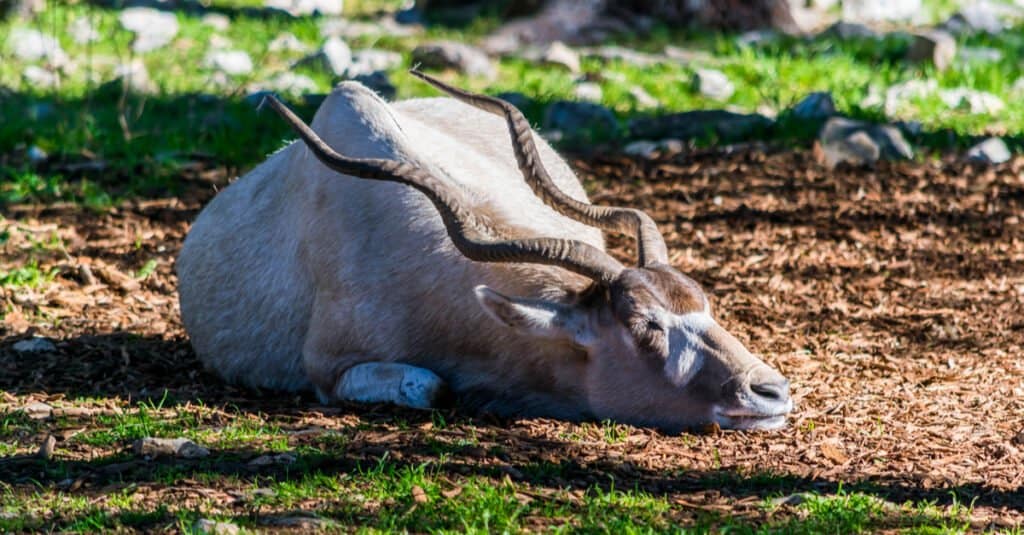
Addax horns can measure between 22 and 43 inches long.
©Begir/Shutterstock.com
Also known as the white antelope or screwhorn antelope, the addax is part of the spiral-horned antelope group. While endemic to the Sahara Desert, few remain in the wild due to uncontrolled hunting. As a result, the IUCN lists them as Critically Endangered, and most remaining members now live in zoos or preserves. Generally, males measure 41 to 45 inches tall and weigh from 220 to 276 pounds, with females measuring smaller. Their coat changes over the course of the year, from gray-brown in winter to white or blonde in summer. While borderline extinct, the addax remains on the list of animals with the biggest horns in the world. Both males and females grow horns and bow in and out with 1 to 2 loops. Female horns typically grow from 22 to 31 inches long, while male horns can reach up to 43 inches long.
#7. Scimitar Oryx
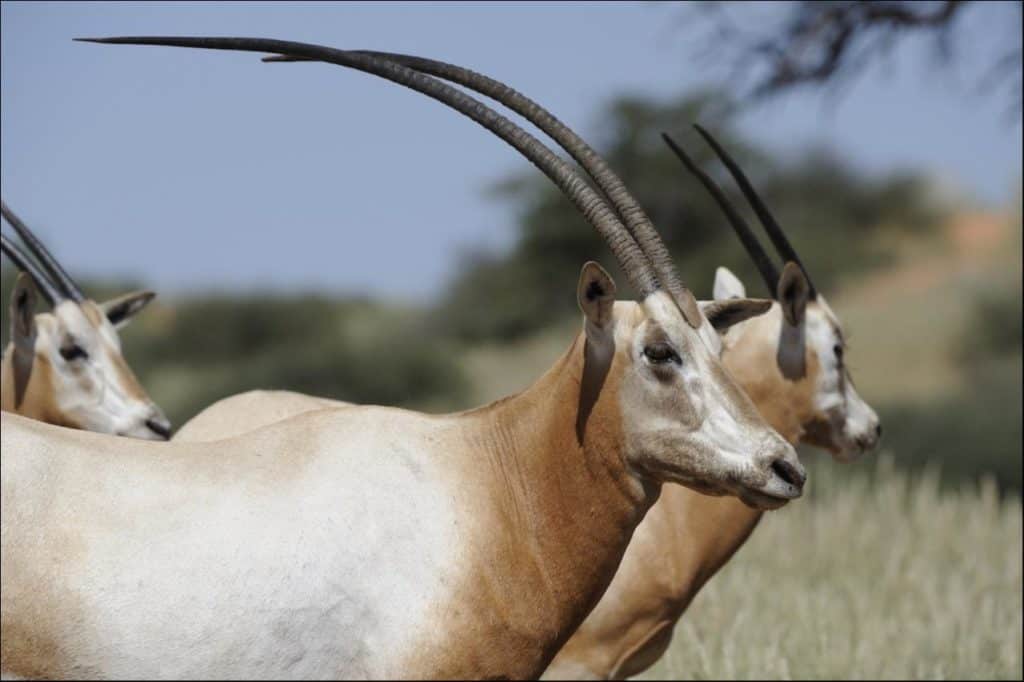
The scimitar oryx gets its name from its horns, which bear a resemblance to scimitars.
©WOLF AVNI/Shutterstock.com
The scimitar oryx is one of the four extant species of oryxes found throughout Africa. Also known as the scimitar-horned oryx, the scimitar oryx has effectively gone extinct in the wild as of 2000. However, a small number still live in closely monitored preserves as well as in zoos worldwide. Unlike other oryxes, scimitar oryxes lack dark face and leg markings, and their horns curve rather than stand straight. They feature a mostly white or beige coat, which helps to keep them cool in the hot desert sun. At their tallest, they stand up to 3.3 feet tall, with males measuring slightly larger than females. Both females and males grow horns, which can grow up to 47 inches long. While classified as straight horn antelopes, scimitar oryxes sport dramatically curved horns. This curve is where they get their name, as their horns look like scimitars.
#6. Elk

Male elk use their antlers to battle each another over breeding opportunities.
©Ghost Bear/Shutterstock.com
Also known as the wapiti, the elk is the second-largest member of the deer family after the moose. They range throughout forests in North America, as well as parts of Central and East Asia. The name “wapiti” is a Shawnee and Cree word, which translates roughly to “white rump.” This refers to their coat, which is off-white or beige from the neck down. Meanwhile, a thick, shaggy mane of dark brown hair covers their neck and usually matches the color of their face. Male elks can stand up to 4 feet, 11 inches tall, and weigh up to 1,300 pounds. Only male elk grow antlers, which can grow up to 1 inch per day until they fully develop. At their largest, they can reach up to 48 inches long and from point to point, and weigh nearly 40 pounds per antler. During the mating season, males will use their antlers to wrestle with other elks to gain mating opportunities.
#5. Caribou
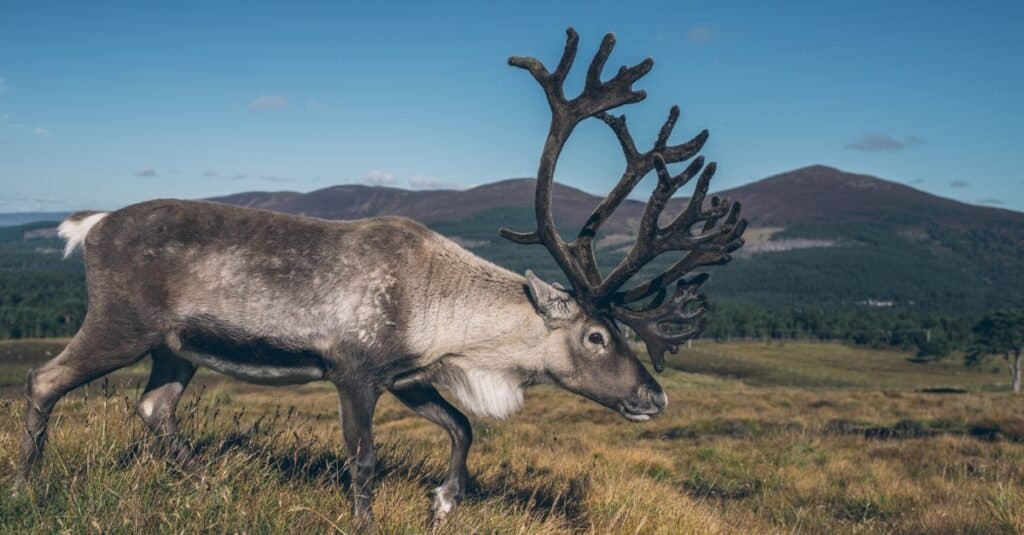
Both male and female caribou grow antlers, which are the largest compared to body size of any deer.
©doliux/Shutterstock.com
Caribou, or reindeer as they are also called, rank in the top half of animals with the biggest horns in the world. They range throughout North America, northern Europe, and Siberia, although the IUCN lists several populations as Threatened. Most caribou live in herds, and while some migrate, others remain in place year-round. Their coat typically looks gray-brown, with a thicker mane growing around the neck. Caribou subspecies vary in size, with the boreal woodland caribou normally measuring as the largest. Both male and female caribou grow antlers, although the size and presence of antlers vary by subspecies. While growing, a thick velvet covers the antlers, which falls off once they stop growing. Amongst all deer species, caribou possess the largest antlers in comparison to their body. At full size, their antlers can reach up to 39 inches point to point, and measure 53 inches long.
#4. Markhor

Markhor means “snake” in Persian and is thought by some to refer to the shape of its horns, which look like coiled snakes.
©BearFotos/Shutterstock.com
The markhor, or screwhorn as it is sometimes known, is a species of wild goat native to Central Asia. In Persian, the word markhor translates to “snake-killer,” due to legends about them killing and eating snakes. They live in mountainous forests and scrublands, with their diet varying between grasses and tree matter depending on the season. While male markhors live alone outside of the mating season, females and young live in small herds. Their coats appear light brown or black and vary in length over the course of the year. On average, they stand between 26 to 45 inches tall and weigh between 71 and 243 pounds. Although both males and females grow horns, male horns grow much larger. The horns connect at the head and corkscrew tightly up and outward. If straightened, male horns can measure up to 63 inches long, while female horns measure much smaller.
#3. Greater Kudu
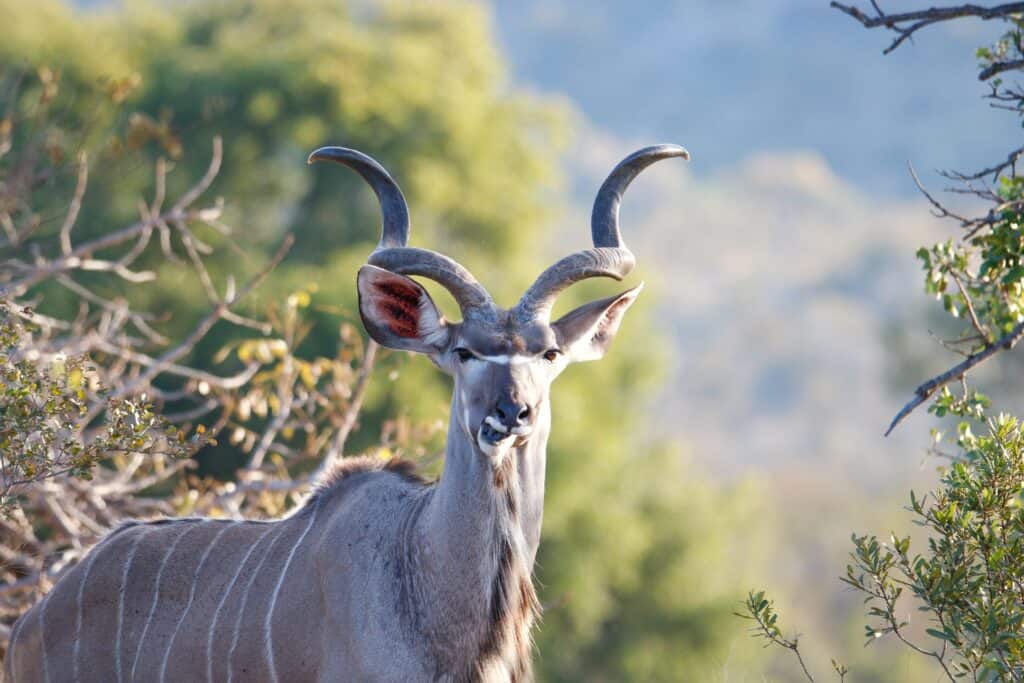
Greater kudu horns can measure up to 74 inches long following the curve.
©Michelle Niemand/Shutterstock.com
The greater kudu is another member of the spiral-horned antelope group along with the bushbuck, eland, and addax. It is one of two species of kudu, the other being the smaller lesser kudu. They range throughout Eastern and Southern Africa, although some populations face threats due to habitat loss and poaching. Greater kudus possess slender bodies and long legs. Their coat appears brownish-gray or reddish-brown, with between 4 and 12 white stripes along their torso. One of the largest antelope species, males reach up to 63 inches tall and weigh between 420 to 694 pounds. In addition to beards, the males also grow long horns, which contain two to three twists. When measured along the curve, their horns can measure from 47 to 74 inches long.
#2. Moose
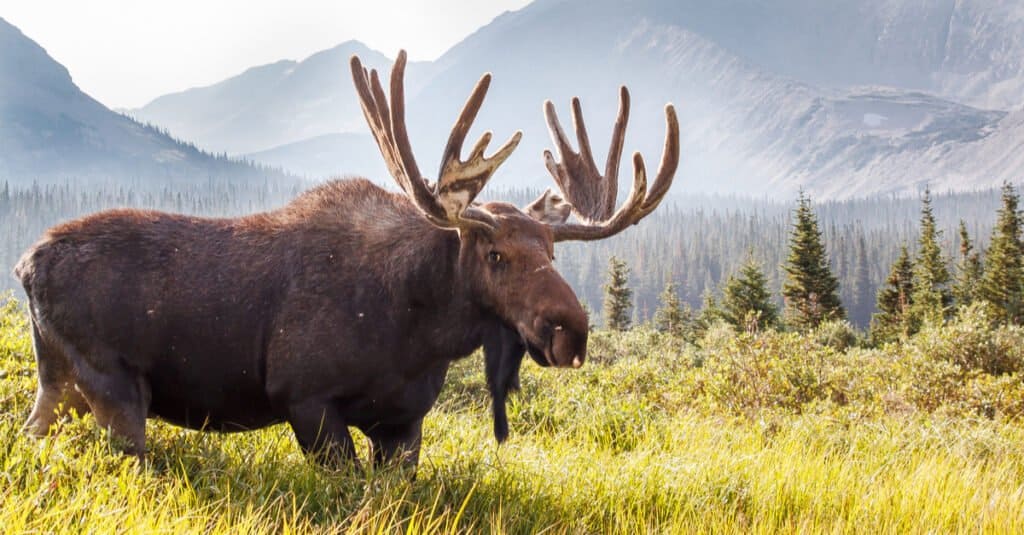
Mose horns can weigh up to 40 pounds each.
©Michael Liggett/Shutterstock.com
The moose is the largest extant species of deer and one of the animals with the biggest horns in the world. Moose live in North America, as well as parts of Poland, Kazakhstan, and Russia, where they go by the name elk. Unlike most deer, moose live alone, and will only meet up during the breeding season to mate. Adults usually stand between 4.6 to 6.9 feet high and weigh from 441 to 1,543 pounds. Only male moose grow antlers, which grow in a dendritic, or twig-like shape. The antlers branch out from the center of the head, before curving upward and broadening out. A mature bull moose’s antlers may measure up to 83 inches from point to point and weigh 40 pounds each. During the breeding season, males may use their antlers to wrestle with one another over mating rights.
#1. Asian Water Buffalo

The world record for biggest horns goes to an Asian water buffalo, whose horns measured 13 feet, 10 inches point to point.
©iStock.com/kimetan
The Asian water buffalo ranks first among the animals with the biggest horns in the world. Also known simply as water buffalo, these domestic bovines historically hail from India and Southeast Asia. Today, they are one of the most abundant buffalo species, with more than 130 million living worldwide. Two types currently exist: the leaner and taller river buffalo, and the stockier swamp buffalo. Their skin can range from black to blue to gray, depending on their age and subspecies. They stand 47 to 63 inches tall and weigh from 660 to 2,400 pounds. Asian water buffalo grow horns that grow outward and curve into a semicircle. Many can reach up to 10 feet from point to point, and measure 60 inches long each. That said, the world record for longest horns belongs to a bull shot in 1955 whose horns measured 13 feet, 10 inches from point to point.
Summary of the 10 Animals With the Biggest Horns in the World
Here’s a recap of the 10 animals with the world’s largest horns that we took a look at.
| Rank | Animal | Horn Size |
|---|---|---|
| 1 | Asian Water Buffalo | 10 feet from point to point and 60 inches long each |
| 2 | Moose | 83 inches from point to point and 60 inches long |
| 3 | Greater Kudu | From 47 to 74 inches long, when measured along the curve |
| 4 | Markhor | Up to 63 inches long, when straightened |
| 5 | Caribou | Up to 39 inches point to point and 53 inches long each |
| 6 | Elk | Up to 48 inches from point to point and 48 inches long each |
| 7 | Scimitar Oryx | Up to 47 inches long |
| 8 | Addax | Up to 43 inches long |
| 9 | Alpine Ibex | Up to 39 inches long |
| 10 | Ankole-Watusi Cattle | 40.7 inches from point to point and 37.5 inches long each |
Thank you for reading! Have some feedback for us? Contact the AZ Animals editorial team.








